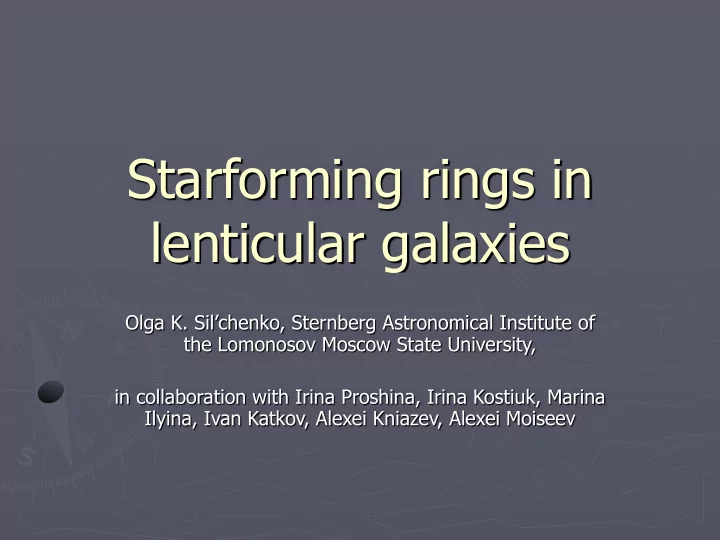

Starforming rings in lenticular galaxies Olga K. Sil’chenko, Sternberg Astronomical Institute of the Lomonosov Moscow State University, in collaboration with Irina Proshina, Irina Kostiuk, Marina Ilyina, Ivan Katkov, Alexei Kniazev, Alexei Moiseev
Starforming rings are rather common in S0-galaxies ► Comeron et al. (2014) – ARRAKIS: up to 60% of S0 have STELLAR outer rings. ► Among those, a half of the rings is seen in FUV, so having suffered recent star formation (Kostiuk & Sil’chenko 2015). ► More than 40% of S0s have cold gas (Welch & Sage 2003, Sage & Welch 2006, Davis et al. 2011, Serra et al. 2011). ► Among gas-rich S0s, a half of the disks demonstrate current star formation – HII regions organized in rings (Pogge & Eskridge 1987, 1993).
A sample of UV-rings
Long-slit spectroscopy of the UV rings ► 11m SALT (Southern-African Astronomical Observatory) + RSS spectrograph; the spectral range 3750-6900 A, spectral resolution of 5.5 A. ► 6m BTA (Special Astrophysical Observatory of the Russian Academy of Sciences) + SCORPIO spectrograph; the spectral ranges are 4800-5400 A (spectral resolution of 2.2 A), 6100-7100 A (spectral resolution of 2.5 A), 3700-7200 A (spectral resolution of 4.5 A). NGC 1211, SALT/RSS
Outer UV-rings…
and i nner UV-rings with current SF SDSS/gri HST/ACS/F625W LCO/r
BPT-diagrams: star formation
FUV-rings without current SF
BPT-diagrams: sometimes shock-like excitation of the gas Ilyina, Sil’chenko, Afanasiev (2014)
Declining star formation histories. Short starbursts? H-alpha NUV FUV
Solar [O/H] of the gas (Pettini-Pagel 2004 calibrations) Very close to the saturation limit of the chemical-evolution models e.g. by Ascasibar+15
Outer stellar disks of S0 galaxies: ► Mean stellar metallicities = -1.0 to -0.3 dex; ► SSP-equivalent stellar ages in the rings of S0s range from 2 to 10 Gyr with a net concentration around T=5 Gyr (Katkov et al. 2015).
Conclusions ► Accreted gas (often with high orbital momentum? - to explain the outer rings detached from the main galactic stellar bodies). ► Brief effective star formation events, at the timescales of a few 10 8 yr. ► Multiple events, with the accreted gas gathering at the same radii?? - To explain the visibility of these rings in S4G (3.6 mkm and 4.5 mkm Spitzer bands).
Recommend
More recommend